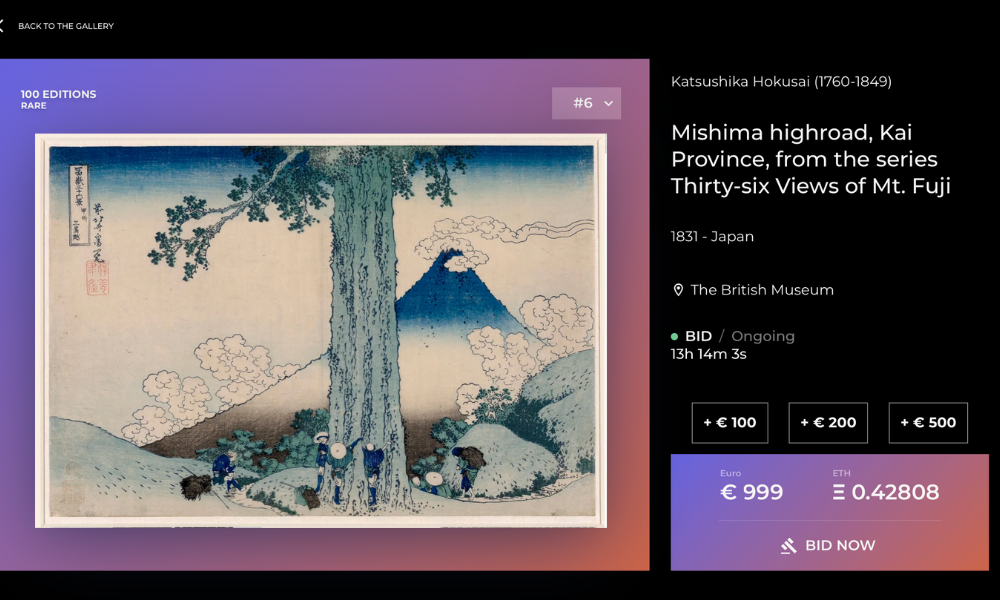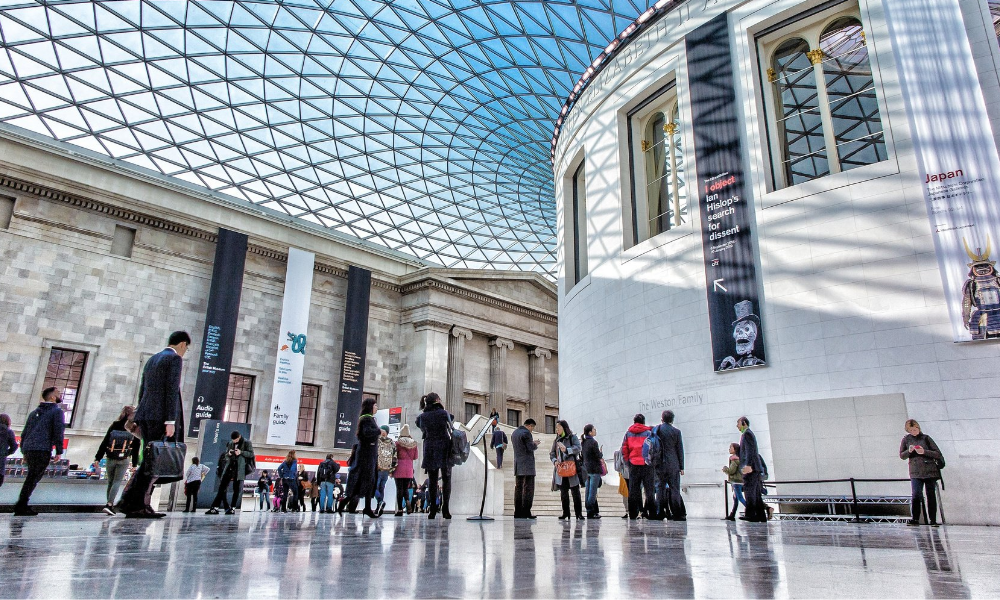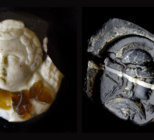What are NFTs?
There exist many technical explanations of NFTs (the unhelpful official name of which is non-fungible token), for those so inclined. For those without a technical background, NFTs are best understood as a certificate of ownership, typically in reference to a digital asset such as an image or video.
Because any image or video can be saved to a device as a new copy (without removing the original), the traditional notion of ‘ownership’ doesn’t really work online. Anyone can save an image to their device without taking the original from a website.
In fact many museums offer high-quality scans of artwork and objects, and users are already perfectly entitled to download a copy for personal use. So what makes an NFT different to an image downloaded to a device? Those who purchase an NFT ‘own’ the file, and there is typically only one.
Like collectible football cards, the limited supply – or scarcity – is effectively the driving force. With one NFT available, a value can be attributed to a digital asset even if copies are rife.
But as any rare Panini card collector should know, owning the card doesn’t mean they own the footballer – or the footballer’s likeness, or the Panini brand, or even its design.
How to make sense of NFTs in museums
Stepping back from the wider hype around NFTs (which has, to date, been driven by financial gains rather than artistic appreciation) they still don’t make much sense in the real world.
However, in a virtual world the need becomes more obvious. Should a museum eventually take all of its exhibits into its own virtual museum (in the metaverse, as it’s known) there is a need to retain ownership in order to maintain a museum’s core proposition; come and see our exhibits here and nowhere else.
Without a system of ownership such as NFTs, digital assets remain infinitely replicable and therefore without value. In this space, copyright laws and copyright claims would be the only tool with which to protect the exclusivity of an exhibit in a virtual museum.
So, to retain a digital asset’s value in this system by which a museum could exclusively introduce its exhibits to the virtual world and continue to procure, display and sell.
If all of this sounds like stretch, it still is. This hypothetical virtual world is yet to fully manifest. NFTs before the metaverse is a bit cart-before-horse. But here, then, is the source of hype; getting in on the ground floor.
The British Museum and LaCollection
Among the museums already hoping to be on the front foot of this brave new metaverse is The British Museum, who has begun to create and sell NFTs of its exhibits via French NFT platform LaCollection.
Jean-Sébastien Beaucamps, co-founder and CEO of LaCollection, comes from a background in digital transformation for sectors including media, banking, insurance.
He admitted that he was an ‘art amateur’ but told Advisor he wants to apply the digital skills he has learned to the art sector with the LaCollection platform.
Beaucamps approached The British Museum with a pitch prior to LaCollection’s official launch, and won against competitors with platforms already up-and-running, he boasts.
What made LaCollection the museum’s choice, he says, is the company’s dedication to only work with cultural institutions.
“They like our positioning and they like our technology strategy. We wanted to propose a very seamless experience,” he told Advisor, which is ultimately to make it as simple as buying from Amazon.

Beaucamps said the partnership was in the seven figure range, but that The British Museum preferred that exact figures were not disclosed. The business model could be seen as similar to that of a brand licensing deal, he explained. The upfront cost, to the museums at least, is zero.
Working with two “key people” within The British Museum’s staff, the project is taking twenty percent of their time.
LaCollection has a five year agreement with The British Museum on its entire collection, and a contract means The British Museum cannot sell NFTs of artwork that has already been put up for sale via its platform.
There are, for instance, ten additions of ‘The Wave’, and no more – this artificial scarcity benefits both LaCollection and The British Museum in keeping the NFTs retain or increase value.
As Beaucamps explains, creating more is “killing the market”, just as selling more physical artworks reduces the value of those that already exist.
Trust is key, he said. “If The British Museum is killing trust then it kills the value of their entire NFTs”.
Asked if these NFTs could have been created without the involvement of the British Museum, Beaucamps points to similar platforms which have already tried to do so.
He said in these instances the museums have and can publicly distance themselves from the platform, which would likely be shut down. So while it is technically possible, without the museum’s support, it seems less likely to survive raising investment.

Who is buying NFTs from museums?
The type of investors LaCollection is targeting don’t want to know how to set-up a crypto-wallet, says Beaucamps. This is the usual process for buying NFTs, but the company has made it so that investors can instead buy NFTs with their credit card.
Its entry NFTs cost around €400 (£334), with plans to bring that cost down further, allowing more people to invest.
“We always want to drop [in other words, release] NFTs with a well defined theme,” he said. “The best way to promote a collection is to do it in the metaverse,” he said.
“We will have in the coming months a museum in the metaverse, which may not only promote artworks but also famous houses, buildings and architecture.”
The British Museum is not the only museum to begin experimenting with NFTs, but Beaucamps claims that some are motivated simply by how lucrative the process currently can be.
As a result, he said, these unnamed museums are offering unique and expensive opportunities “for very rich people”. Instead, the mission at La Collection is to “democratise culture”, and offer less expensive options.
On the other end of the art spectrum is the NFT market’s current most successful designs – which consist of simple, cartoon graphics, a far cry from the art within the most prestigious museums.
Cryptopunks and Bored Apes, two sets of NFTs which have bled most successfully into popular culture, consist of cartoon characters with randomly generated combinations of features and clothing.
Marlène Roche, LaCollection’s resident Art Advisor said “designers are emerging, but in the long-run it will only be the qualitative NFTs that will stay and make history. It’s super important that platforms like LaCollection exist and grow… to showcase artists and institutions with strong historical values.”
These more popular NFTs, regardless of their artistic value, have found their place in youth culture. And it’s here that Beaucamps said museums could stand to benefit from NFTs.
“For museums like The British Museum and Louvre, [reaching young people] is a real issue. We’re giving them access to an audience composed of much younger people”. These people – NFT investors – are around thirty-two years old and are “international”.
Getting that young audience to take notice and invest in NFTs falls to LaCollection, rather than The British Museum.
Reaching that younger audience of investors will primarily be carried out via Instagram, and for seasoned NFT investors, Twitter, Discord and specific events and conferences on NFTs, he said. Still, The British Museum reviews these key messages.
The NFT opportunity for smaller museums and heritage sites
LaCollection is currently hoping to work with a roster of ‘Tier 1’ museums, and has had to turn down interest from museums which don’t fall into this category.
But for smaller museums looking to get into NFTs, there is still an opportunity as “some smaller museums have treasure in their collection and nobody knows it”, he said.
In time, NFTs could become a way to improve the awareness of smaller museums and the objects within. “We’re at the very very beginning of the story of NFTs”, he said. “It’s not just about collecting and investing.”
Both Roche and Beaucamps said NFTs could extend into architecture too, allowing heritage sites a new opportunity, but all of this is even further into an unknown future which is still unfolding somewhere in a metaverse yet to inhabit most of the world.










